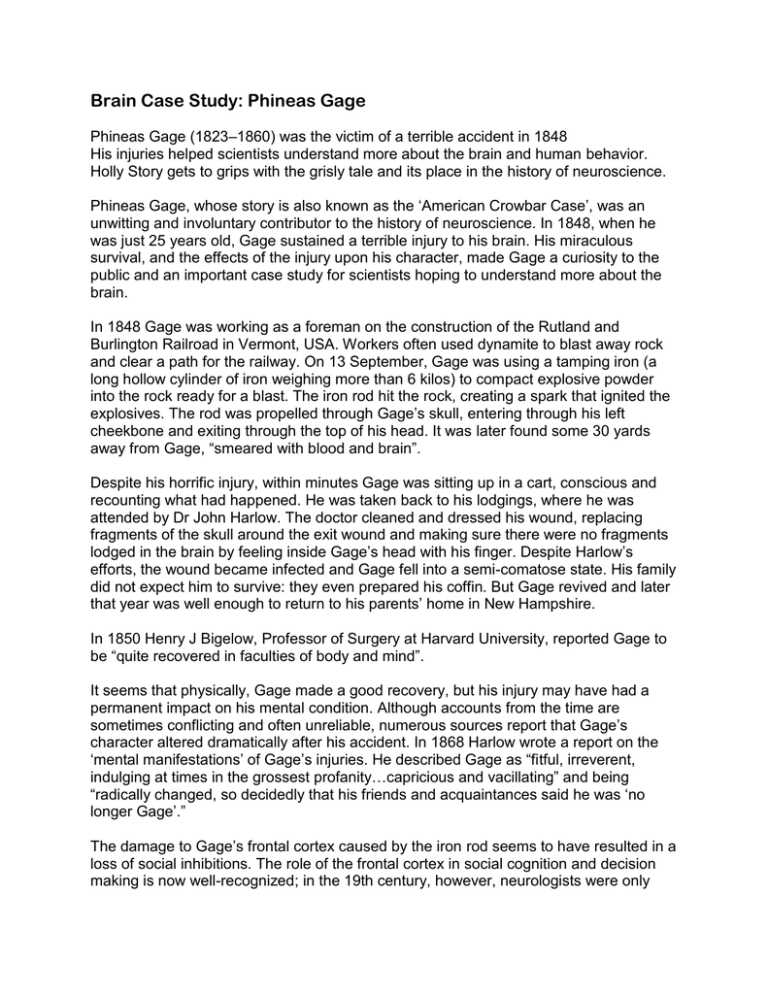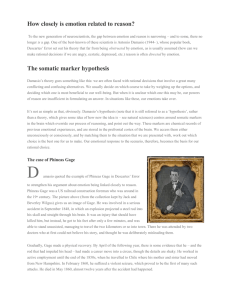Phineas Gage Case study - West Ada School District
advertisement

Brain Case Study: Phineas Gage Phineas Gage (1823–1860) was the victim of a terrible accident in 1848 His injuries helped scientists understand more about the brain and human behavior. Holly Story gets to grips with the grisly tale and its place in the history of neuroscience. Phineas Gage, whose story is also known as the ‘American Crowbar Case’, was an unwitting and involuntary contributor to the history of neuroscience. In 1848, when he was just 25 years old, Gage sustained a terrible injury to his brain. His miraculous survival, and the effects of the injury upon his character, made Gage a curiosity to the public and an important case study for scientists hoping to understand more about the brain. In 1848 Gage was working as a foreman on the construction of the Rutland and Burlington Railroad in Vermont, USA. Workers often used dynamite to blast away rock and clear a path for the railway. On 13 September, Gage was using a tamping iron (a long hollow cylinder of iron weighing more than 6 kilos) to compact explosive powder into the rock ready for a blast. The iron rod hit the rock, creating a spark that ignited the explosives. The rod was propelled through Gage’s skull, entering through his left cheekbone and exiting through the top of his head. It was later found some 30 yards away from Gage, “smeared with blood and brain”. Despite his horrific injury, within minutes Gage was sitting up in a cart, conscious and recounting what had happened. He was taken back to his lodgings, where he was attended by Dr John Harlow. The doctor cleaned and dressed his wound, replacing fragments of the skull around the exit wound and making sure there were no fragments lodged in the brain by feeling inside Gage’s head with his finger. Despite Harlow’s efforts, the wound became infected and Gage fell into a semi-comatose state. His family did not expect him to survive: they even prepared his coffin. But Gage revived and later that year was well enough to return to his parents’ home in New Hampshire. In 1850 Henry J Bigelow, Professor of Surgery at Harvard University, reported Gage to be “quite recovered in faculties of body and mind”. It seems that physically, Gage made a good recovery, but his injury may have had a permanent impact on his mental condition. Although accounts from the time are sometimes conflicting and often unreliable, numerous sources report that Gage’s character altered dramatically after his accident. In 1868 Harlow wrote a report on the ‘mental manifestations’ of Gage’s injuries. He described Gage as “fitful, irreverent, indulging at times in the grossest profanity…capricious and vacillating” and being “radically changed, so decidedly that his friends and acquaintances said he was ‘no longer Gage’.” The damage to Gage’s frontal cortex caused by the iron rod seems to have resulted in a loss of social inhibitions. The role of the frontal cortex in social cognition and decision making is now well-recognized; in the 19th century, however, neurologists were only just beginning to realize these connections. Gage’s injuries provided some of the first evidence that the frontal cortex was involved in personality and behavior. One of the pioneering researchers in this field at the time was David Ferrier, a Scottish neurologist who performed extensive experimental research into cerebral function. In a lecture to the Royal College of Physicians in 1878, Ferrier observed that in his experiments on primates, damage to the frontal cortices seemed to have no effect on the physical abilities of the animal but brought about “a very decided alteration in the animal’s character and behavior”. He used the experience of Phineas Gage as a case study to support his claims. The details of Gage’s life after his accident are unclear. It is known that he worked as a coach driver for several years in New Hampshire and then in Chile and that in 1859 his health deteriorated and he returned to New Hampshire to live with his mother. He died in San Francisco in 1860 after suffering seizures that resulted from his injury. His brain was not examined after his death, but in 1867 his body was exhumed and his skull was sent to Dr. Harlow to be studied. It now resides, along with the tamping iron, at Warren Anatomical Museum at the Harvard University School of Medicine. Since then, scientists have made various attempts to use the skull to reconstruct Gage’s injury and establish which areas of his brain were damaged. Most recently, a team led by Jack Van Horn of UCLA’s Laboratory of Neuroimaging (part of the Human Connectome Project) created a new digital model of the rod’s path. It suggested that the damage to Gage’s brain was more extensive and severe than had previously been estimated: up to 4 per cent of the cerebral cortex and about 11 per cent of the total white matter in the frontal lobe were destroyed. The model also indicates that the accident damaged the connections between the frontal cortex to the limbic system, which are involved in the regulation of emotions. This would seem to support some of the contemporary reports of Gage’s behavior. In the 19th century, Gage’s survival seemed miraculous. Fascination with his plight encouraged scientific research into the brain, and the continuing research into Gage’s condition is proof that this same curiosity is still alive today. REFERENCES Passage of an iron rod through the head (1848) Dr Harlow’s case of recovery from the passage of an iron bar through the head (1850) Recovery from the passage of an iron bar through the head (1868) Phineas Gage’s connectome This resource was first published in ‘Inside the Brain’ in January 2013 and reviewed in May 2014.




